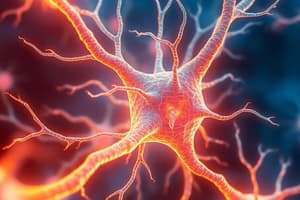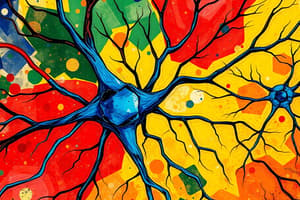Podcast
Questions and Answers
Which of the following best describes the primary function of the nervous system?
Which of the following best describes the primary function of the nervous system?
- To produce hormones for growth and development
- To filter waste products from the blood
- To control and regulate all other systems of the body (correct)
- To transport nutrients throughout the body
Nervous tissue is primarily composed of neurons and glial cells.
Nervous tissue is primarily composed of neurons and glial cells.
True (A)
What is the role of glial cells in nervous tissue?
What is the role of glial cells in nervous tissue?
Support and protect neurons
The part of the neuron that typically receives signals from other neurons is the ________.
The part of the neuron that typically receives signals from other neurons is the ________.
Which component of a neuron transmits electrical impulses away from the cell body?
Which component of a neuron transmits electrical impulses away from the cell body?
The nucleus is responsible for producing proteins and lipids needed by the neuron.
The nucleus is responsible for producing proteins and lipids needed by the neuron.
Where does the transmission of nerve impulses occur from one neuron to another?
Where does the transmission of nerve impulses occur from one neuron to another?
The direction of ________ ________ represents the path an electrical signal travels along the axon.
The direction of ________ ________ represents the path an electrical signal travels along the axon.
What is the primary function of the synaptic end bulb?
What is the primary function of the synaptic end bulb?
Axons receive input from many other neurons and carry those signals to the cell body.
Axons receive input from many other neurons and carry those signals to the cell body.
Match the neuron structure with its function:
Match the neuron structure with its function:
Which of the following structures helps support the cell body?
Which of the following structures helps support the cell body?
The signal always travels from the synaptic end bulb toward the dendrites of another neuron.
The signal always travels from the synaptic end bulb toward the dendrites of another neuron.
What type of non-neuronal target does the electrical impulse from an axon carry to?
What type of non-neuronal target does the electrical impulse from an axon carry to?
Nervous tissue is made up of nerve cells also called ________, and support cells called glial cells or neuroglia.
Nervous tissue is made up of nerve cells also called ________, and support cells called glial cells or neuroglia.
What is the relationship between the nervous system and the endocrine system?
What is the relationship between the nervous system and the endocrine system?
The nucleus is the part of the neuron that carries electrical signals to other cells.
The nucleus is the part of the neuron that carries electrical signals to other cells.
What two substances does the cell body of a neuron regulate production of?
What two substances does the cell body of a neuron regulate production of?
The axon carries electrical impulses and projects to ________ with dendrites or cell bodies of other neurons.
The axon carries electrical impulses and projects to ________ with dendrites or cell bodies of other neurons.
In which direction does the nerve impulse travel?
In which direction does the nerve impulse travel?
Flashcards
Nervous Tissue Composition
Nervous Tissue Composition
Nervous tissue is composed of nerve cells and supporting cells
Axon
Axon
A long, slender projection of a nerve cell that conducts electrical impulses away from the cell body.
Dendrites
Dendrites
Branch-like extensions of a neuron that receive signals from other neurons.
Cell Body
Cell Body
Signup and view all the flashcards
Nucleus (Neuron)
Nucleus (Neuron)
Signup and view all the flashcards
Axon Terminal
Axon Terminal
Signup and view all the flashcards
Direction of Action Potential
Direction of Action Potential
Signup and view all the flashcards
Cell body Function
Cell body Function
Signup and view all the flashcards
Axon Function
Axon Function
Signup and view all the flashcards
Dendrite Function
Dendrite Function
Signup and view all the flashcards
Synaptic End Bulb Function
Synaptic End Bulb Function
Signup and view all the flashcards
Study Notes
- The nervous system works with the endocrine system to control and regulate all other systems of the body
- Nervous tissue is made of nerve cells (neurons) and supporting cells (glial cells, neuroglia)
Neuron Structure and Function
- Cell body: Stores organelles and regulates the production of proteins and lipids needed by the neuron.
- Axon: Carries electrical impulses and projects to synapses with dendrites or cell bodies of other neurons or with non-neuronal targets such as muscle fibers.
- Dendrite: Receives input from many other neurons and carries those signals to the cell body.
- Synaptic end bulb: Transmits nerve impulses from one neuron to another or to an effector cell.
Studying That Suits You
Use AI to generate personalized quizzes and flashcards to suit your learning preferences.




